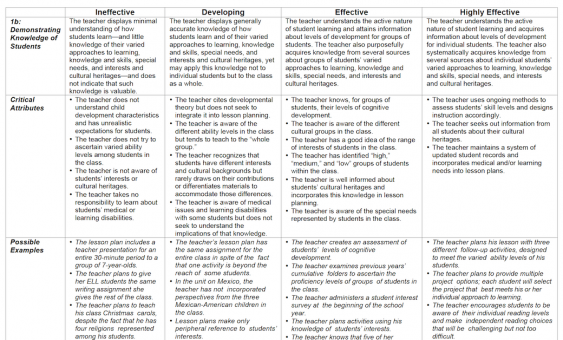A Teaching Observation Self-Defense Strategy

I’m that girl. The really…um…”challenging one” who is not satisfied with a 97. The one who wants extra credit, the one who asks for more homework, the girl who does test corrections when she misses one question.
I’m actually not that girl anymore; rather, I’m that woman, who now wants all 4’s on my teaching observation next week. I know I’m not a perfect teacher, and I’m always looking for ways to improve my practice. Yet, I can’t help myself: it’s like the gauntlet has been laid down, and now I must accept the challenge.
Observation pre-conferencing
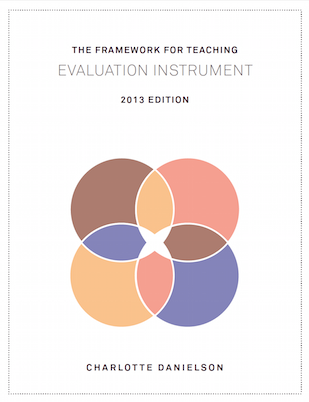
According to the Danielson Group, “The Framework may be used for many purposes, but its full value is realized as the foundation for professional conversations among practitioners as they seek to enhance their skill in the complex task of teaching.” As we talked in the pre-conference, I had several revelations about the nature of observations and the pro’s and con’s of the Danielson rubric.
Observations should be more than once a year
As a tenured teacher, I am only formally observed for an entire class period once a year, and I also have a 10 minute walk-through. I’ll admit that in the past I’ve thought once was more than enough, but as I talked to my principal last week, I realized that in order to really consider what I do in the classroom, it is impossible to talk about one day. Luckily, he was amenable to a more in-depth conversation.
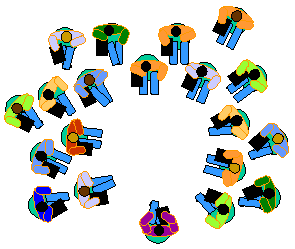
The audience will be taking notes that they will later be allowed to use for their final assessment. If all goes as planned, everyone will be engaged. Even me. I’ll be filling out the discussion rubric for each of the five or six students in the fishbowl while I monitor the audience to make sure that they are taking appropriate notes.
The problem that I encountered when discussing this lesson was that on the day my principal will be observing, I’m going to be acting as a facilitator, ultimately monitoring and moderating conversations. He won’t see me as I debriefed students after our first round of fishbowls a few weeks ago.
He won’t see that I created the audience notesheet because my classes needed more structure than the directive to “take notes” that I used last time. He won’t see that the groups are organized with a person who will step up and be a leader at each table, information that I have learned from careful observation over the last two months.
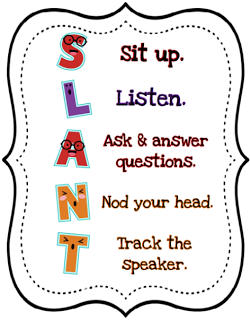
You get the point. He won’t see it all because he can’t see it all in one lesson. There are so many layers to what we do in the classroom that it is inconceivable to expect a 40-minute visit to encapsulate who we are as teachers. Yet, that is what is going to happen to me next week.
It’s impossible to demonstrate total proficiency
A potential downside to the Danielson rubric is that if it is used as an all-encompassing measure of teacher proficiency based on a single observation, or frankly, even two, it is impossible to score all 4’s. My perfectionism aside, the fact is, many states are weighting teacher observations very heavily; in New York, next year the observation score will be 50% of my overall APPR score. The other 50% is student assessments.
The lesson my principal observes will not allow him to see my questioning techniques or an example of formative assessment; however, the lesson he will observe is the result of those questioning techniques and the use of the first fishbowl as a formative assessment.
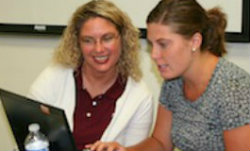
The great thing about my pre-conference is that my principal provided an important opportunity – the chance to give him what I call “the backstory.” He’s also made it clear that I should bring any artifacts with me to the post-conference to help him understand the lesson as a part of my teaching instead of all there is to my teaching.
We have to put our teaching in context
“Shut up!” you yell to your friend when she tells you that she got the job she’s dreamed about for years. “Shut up!” the lady in front of you at the grocery store yells to her small child. “Shut up!” your husband says, laughing at your latest escapade with your crazy neighbor. It’s all about the context, right? The “story behind the story” is important.
The fact is, my students didn’t just show up knowing how to have a collegial conversation with prepared notes. The fact is, some of these students worked on this in their academic support class with our special education teachers. The fact is, the little girl who isn’t saying much has a very sick mom or the boy who is fidgeting hasn’t adjusted to new meds yet.
Danielson rubric sample – click to enlarge
Now, those are hypothetical situations, but I bet you know the backstory of your students too. Include that information in your pre-conference. Danielson’s rubric measures your knowledge of students, how you’ve created an environment for learning, and the way you’ve planned for these students, so it is your job to convey that to an observer because it isn’t necessarily observable from a classroom visit.
The Danielson rubric is looking for the right attributes in a teacher. There is no doubt in my mind that the teacher who does score well on the rubric is dynamite because the requirements for a four call for student-driven curriculum, student-led classroom management, and differentiation.

As I left the pre-conference, I felt like I had just interviewed for the job because that was the last time I presented myself in this somewhat microscopic manner. I had essentially done a portfolio presentation. One of the pro’s of the rubric is that it required me to be reflective and consider my practice.
Teachers should have a professional portfolio
Now, you say, “What? You want to add more work by requiring a portfolio? More work? I teach all day, I plan all the time, I grade continually, and I dream about this job.” Yes, that is exactly what I am saying. However, a portfolio should not be difficult to create if you are already doing the right things in the first place.

Teachers must be prepared to meet each new challenge, and at this moment in time, teacher observation is high profile and high stakes for us. There’s no harm in keeping an organic, living document of our work as teachers. It can make us more reflective and improve our practice. With the ease of technology this should be simple; when I suggested creating folders, I wasn’t talking about a physical folder, but one on your desktop. The profession has evolved, and our definitions of ourselves as teachers must as well.
An observation – with a Danielson rubric or otherwise – should be approached as an opportunity to value what we do each day by giving it our attention. Will I get all 4’s next week? That is doubtful. Will I showcase an awesome lesson where I’ve empowered 8th graders to lead discussions? Yes, and as long as what I’m doing is worthwhile and educationally sound, the Danielson rubric will measure what I do – just not all at the same time.
Fishbowl image: Atherton J S (2013) Learning and Teaching; Physical Layout [On-line: UK] retrieved 24 November 2015.
Amber Rain Chandler (@msamberchandler) is a National Board Certified ELA teacher at Frontier Middle School in Hamburg, NY, a suburb of Buffalo. She is also a certified School Building Leader, teaches Methods in English Teaching at Medaille College, and leads staff development on Differentiation for the Southtown Teachers Center. She writes frequently for MiddleWeb and other publications, including Getting Smart. Visit her website.

